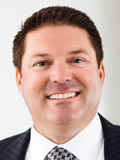On the deal flow side, how would you characterize the level of activity that you are seeing versus what it was a year ago? If activity is higher, is it the result of more deal flow from existing sources or an increase in the number of origination sources, or both?
Shauna Heckathorn: We are seeing a steady increase in business volume, mostly from an increase in the number of partners, particularly through our vendor channel. The bump was most significant in Q1/2018 but is continuing into 2019. This may in part be due to the increasing dividends from fixed cost efforts such as the creation of program interfaces between systems to allow the submission of electronic applications and other process efficiencies. Sustained production volumes are required to make such investments worthwhile for either party. In our wholesale channel, we have also seen a consolidation with the number of brokers with million dollar-plus relationships increasing in number.
Jeffrey A. Hilzinger: Marlin’s origination volume continues to grow in line with our public guidance of 15% to 20% per year, which is being driven by our ongoing transformation from being a micro-ticket equipment finance company into a broader provider of credit products and services to small businesses.
More specifically, our increased activity is being driven by several factors including significant growth in our direct channel, significant growth in our working capital loan product, our recent acquisitions of Horizon Keystone Financial and Fleet Financing Resources and an increase in our average ticket size.
Jim Jenks: The economic forecast for 2018 was for it to be a strong first half or nine months, and then we should expect to see some slow down. That is exactly what we have experienced throughout 2018 and into 2019. Although we have seen a slight pickup in March, we expect to see it pretty steady for the year.
Deborah J. Monosson: It’s a bit more activity than we saw in Q1/2018. Deal flow is up but closing them takes more time. There seems to be more negotiation and demands from the lessees each year.
David Normandin: Activity is up overall. Many of our originating partners have expanded niche markets and others are taking advantage of consolidation in the market that has left incremental business open to increase their share of the wallet.
Do you expect that to continue? What are the key drivers behind your optimism/pessimism?
Michael Green: We do expect it to continue through 2019. Our existing sources continue to deliver origination growth as our relationships deepen. In addition, there is a healthy pipeline of new sources that are interested in working with us.
Heckathorn: There are headwinds to overall economic growth that do signal an increased risk of deceleration in business investment. These include the eventual need to rebalance Treasury deficit spending, signals of an overall upwards drift in interest rates from a sustained period near history lows, and a tapering of global growth trends. That said, the regulatory and tax environment for businesses in the U.S. remains highly favorable.
Monosson: I expect our deal flow to be flat over last year. We are in a niche market of equity-backed startup companies. There is a lot of money out there to be invested, and with a growing cannabis industry with a lot of equipment needs, we’re hoping to be able to grow in that space.
Normandin: I am optimistic in some segments that have been disrupted by change (either within the financial community or within the broader business model) and other markets I see are flat and could sag. Additionally, the economic fundamentals are good and that can be lost in the political noise which I believe results in strong variance in market confidence. In the end, I do think that 2019 will be a solid year for the commercial equipment finance industry.
For your company, what are some of the factors you’ve had to deal with when you go to the marketplace to compete?
Heckathorn: It is always healthy to respect and monitor the activities of competitors, and it is clear that the industry as a whole is upping its game. Equipment financiers are increasingly streamlining the application process to meet the expectations of their customers. Information technology represents a critical enabler for this level of service, and, as we invest in developers and data scientists in-house to keep us at the forefront of these developments, so are our larger competitors.
We also recognize that there has been a strong supply of capital to the equipment finance industry, based on an ever-strengthening track record of asset-backed transaction performance. This has created a highly price-competitive environment amongst responsible lenders.
Hilzinger: Over the last three years, Marlin has faced a host of new competitors, including alternative lenders in our direct channel and payments companies morphing into finance companies in our indirect channel.
The common theme between all these new competitors is the emergence of borrowing processes which are both digital and mobile. Because these new processes only serve to reinforce speed and convenience, we believe that this trend toward digital and mobile is both permanent and accelerating. This trend needs to be an important strategic consideration for any small balance lender competing in today’s marketplace.
Monosson: In our niche, we are not competing against other lessors in our space, [but] we have lost deals to the investors themselves. The investors often review our lease proposals and a light bulb goes off in their head: “We can do this.” And they take the deal from us. It’s very frustrating.
Normandin: We consistently see high levels of competition that can result in aggressive pricing and aggressive risk profiles. While this is not new, the depth of credit being purchased at the low reserve levels is troubling as I remember this in 2007.
What do you view as some of the major differences between operating as an independent funding source versus a captive or bank?
Green: Banks have essentially unlimited inexpensive capital at incredibly high leverage. While they have zero appetite for delinquency and loss, they can offer prices nearly impossible for an independent to match. And while low rates get commoditized in a competitive environment, banks compete on the value and service they provide for their customers. Independents compete by finding a niche that is underserved by the banks and captives. This customer is less rate sensitive by definition as they know they can’t get bank financing.
Monosson: The major difference in our niche as an independent is that the banks cannot take the credit risk that we can take. They also can’t work as quickly or as flexible as an independent. We can make up the rules as we go. [But] on the captive side, it’s quite different. If they are a true captive, they do take the deal from us, they control their own equipment, they can take the risk and if they get the equipment back, they can remarket it. If it’s a captive backed by a 3rd party, then its maybe they will, but mostly they won’t take a credit risk.



What do you view as a key component to improving the odds of getting a deal done when working with a broker?
Heckathorn: Key components to increasing and maintaining high closing ratios are understanding the respective credit envelopes and the consistency of underwriting decisions. The key to achieving both is an enduring relationship, through which both the broker and the financing partner gain an appreciation for each other’s respective go-to-market strategy.
Hilzinger: Like most intermediaries, brokers value speed and consistency from their funding partners. They also want to know that their customers will be well treated during both the funding process and over the servicing life of the financing. Our experience would say that if there is strong alignment between a broker’s origination strategy and the funding source’s risk appetite, there is a strong likelihood that a successful partnership will develop over time.
Jenks: The key components in working with us is that the broker has the first opportunity to get the story from their lessee prior to submission. More experienced brokers will review the information collected from their customer and ask questions pertinent to [that] information. They will [then] tee up the customer as to what type of structure, monthly payments, etc. they can expect to receive from a funding source.
Normandin: Truly understanding the context of the opportunity and selling that to the funding source with a complete package that allows the funding source to say yes quickly and not have to go back and forth.
Between the tax reform bill in late 2017 and the tariffs enacted over the last year, the market has seen a great deal of volatility. How has business been affected and how do you see those effects playing out over the next year?
Green: Luckily, our growth met expectations as I don’t believe our core customer was greatly affected by either of these. But as the full effects become known over the year, we will see how it filters into our customer’s world.
Hilzinger: In the small business marketplace, the tax reform bill was welcome relief and served to further strengthen what was already very positive sentiment in this important part of the U.S. economy. Since then, that sentiment has waned a bit over concerns that the new tariffs and rising interest rates are impeding growth.
While we do not see any empirical evidence that this sentiment has materially changed business performance or investment behavior, our anecdotal experience would suggest that small businesses have become more cautious in recent months.
Jenks: We believe the most significant issue facing the U.S. economic growth will be on what happens overseas. China in particular is experiencing an economic slowdown, led by their slump in auto sales and their own massive debt burden (at an estimated 300% debt to GDP ratio). As the second largest economy in the world, their slowdown has a ripple effect. It appears that resolving the tariff dispute with the United States would help China more than hurt them.
Monosson: Most if not all of our clients are generating losses, so taxes are not really affecting them in a meaningful way. As far as tariffs, we have not seen our lessees or potential lessees affected as most of them are U.S.-based and buying from U.S. vendors. If those vendors are experiencing price increases due to the tariffs, we don’t see them.
Normandin: Tax reform is just now being realized in an experiential way that will boost confidence, and I expect that will have a positive influence in 2019. Tariffs are more industry-specific. For example, tariffs have been a significant blow to agriculture yet have built confidence in areas of manufacturing. Depending upon where you do business, I would suggest your experience will be quite different as it pertains to tariffs.
What other challenges/opportunities do you anticipate in the future?
Green: I think all of us are keeping an eye out for some sort of economic slowdown. The challenges that brings to mind are: reduced equipment demand, lower income for our customers, increased delinquency, increased equipment supply and reduction in values. Yikes, hate all those.
All that said, there continues to be great opportunities for equipment finance companies that provide a compelling value proposition to a customer base that it serves well.
Heckathorn: Equipment finance is an inherently stable industry; however, we must assume that the economic cycle will kick downwards at some point. Whereas the Fed will control monetary policy carefully as a lever, consumer and business confidence shifts can be more dramatic and less predictable. From a credit or portfolio perspective, we again have to respect that these trends will surprise us and therefore consistently maintain a diversified industry and asset mix to be prepared at any time.